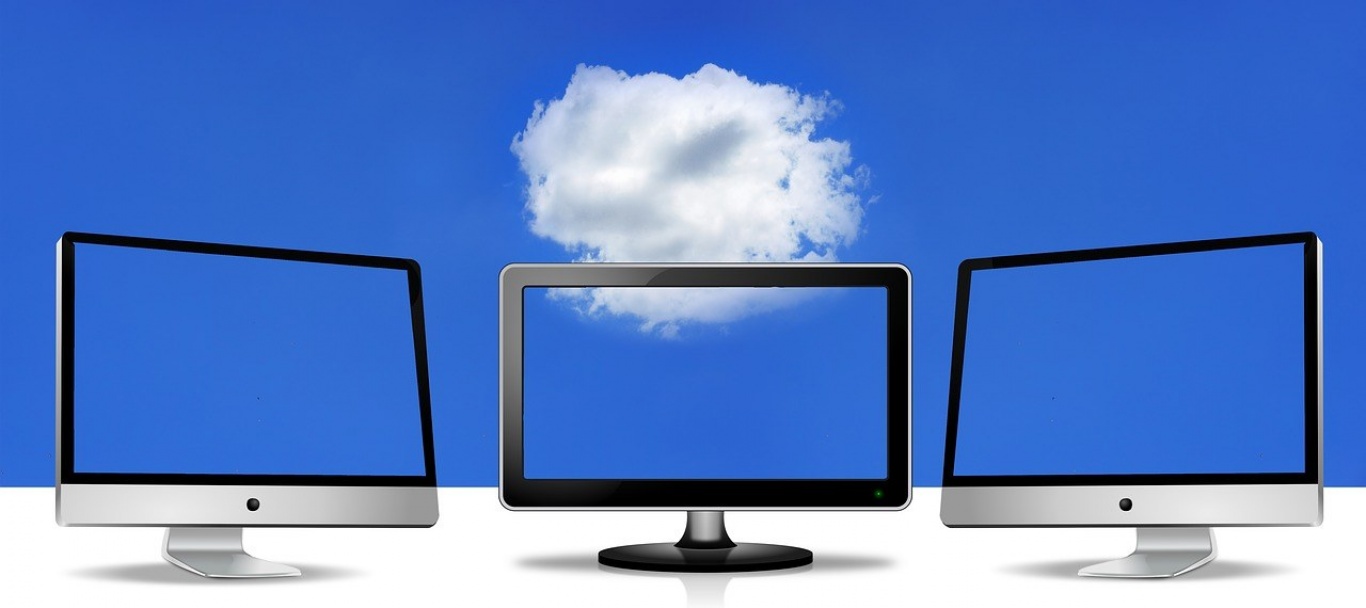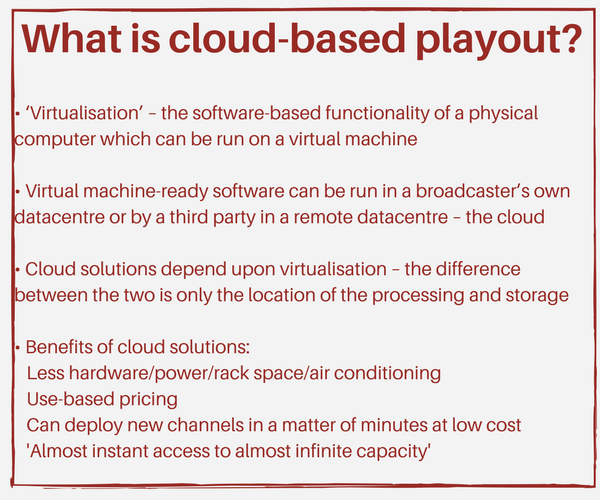
Is cloud-based playout a) inevitable, and b) good for business?
"Any broadcast vendor should be moving to all-software solutions which can be run in virtual machines, or they will be left behind"
That was the view of James Gilbert, CEO of Pixel Power, in January 2016But it’s worth noting that he also said that the cloud “is not something to get excited by for its own sake...just because it is shiny and new – in our industry, at least – does not mean that it is inherently better”.
Virtual machines – and ‘virtualisation’ – offer the software-based functionality of a physical computer which can be run in a broadcaster’s own datacentre or by a third party in a remote datacentre – the cloud.
Cloud solutions depend upon virtualisation – the difference between the two is only the location of the processing and storage – and can bring several benefits, such as a reduced need for hardware, power, rack space and air conditioning.
There are several benefits of cloud solutions, including a reduction in hardware/power/rack space/air conditioning, plus use-based pricing, the ability to deploy new channels in a matter of minutes at low cost and, according to James Gilbert, “almost instant access to almost infinite capacity”.
Ultimately, the result should be that software should look and perform identically whether it is under your desk, in the basement or thousands of miles away.

Earlier this year, we explored the move of broadcast content workflows from baseband to IP and found that IP solutions were emerging in playout, MCR, studio and live production environments – areas that have traditionally been the realm of SDI baseband.
IP brings benefits including scale and flexibility, and moving to the cloud is now likely to be a decision based on business preferences rather technological capabilities.
Eighteen months on from Mr Gilbert’s ‘left-behind’ comment, which service providers and manufacturers are ready for the move?
The barriers
Content location
Broadcasters, traditionally, like knowing where their content is, in a physical sense: be it tapes in their library or files on a server in their own rack room. It takes a leap beyond comfort zones to operate without knowing the location of their content which is hosted by a third party.
There may even be contractual restrictions on the movement of content between territories or to third party providers.
Costs
Service providers must also consider costs – both the initial outlay on infrastructure as well as operational, including staff, but how practical and reliable is it to move content to and from the cloud?
Private cloud or public?
If software can be virtualised, it can be run in the cloud. Which leaves service providers with two options: a private cloud or a public cloud?
Public and private clouds appear to be very similar: both deliver IT infrastructure and network services to host software programs and provide data storage.
A public cloud is an off-premise system that provides computing and storage over the internet from a third-party supplier. The broadcaster has little or no control over the physical aspects of the servers, storage or network.
Video on demand is a terrific fit for cloud services because of its unpredictable and variable nature. Deluxe uses a public cloud, and both Netflix and the BBC iPlayer are hosted by Amazon Web Services (AWS), which is available to anyone.
A private cloud, on the other hand, refers to a similar computing and storage system under the direct control of a broadcaster which may be off or on their premises.
DMC, in Amsterdam, recently launched a full-IP virtualised playout platform based on Pebble Beach’s Orca system using a private cloud.
The platform, which delivers 30 channels today, will be used by more than 80 channels in Europe from September 1, 2017, following the full migration of remaining channels from DMC’s former facility. The all-IP architecture enables DMC to commission and deliver new channels in “a matter of hours instead of weeks”, with the potential to reduce this to minutes.
Manufacturers
SAM (Snell Advanced Media) seem well-placed in delivering content via the cloud: the Berkshire-based company was part of the successful broadcast of two live, IP-based multi-camera shows in November 2016 by the Dutch commercial channel RTL4.
The manufacturer also played a significant role in a more recent broadcast – keep reading for details.
And Pebble Beach Systems, as mentioned above in their role at DMC, will use this year’s IBC to spotlight its latest range of solutions that have been ‘virtualised’ for improved productivity.
Will premium channels migrate to the cloud soon?
But what about premium linear channels?
James Gilbert, CEO of Pixel Power, January 2016:
Delivering Ultra HD from the cloud
If ultra HD simply means more and/or better pixels, it’s just a case of handling more ones and zeros. More bits.
In fact, just a few days ago, the ‘world’s first’ uncompressed UHD 4K IP remote production trial took place successfully during the final of the 2017 UEFA European Under-21 Championship, which once again involved Snell Advanced Media.
André Nel, UEFA’s Senior Broadcast Engineering Manager, said the test “represents a major milestone for UEFA” – and he has a point: European football’s governing body faces a challenge to successfully broadcast matches played in 13 different countries during its senior continent-wide competition in 2020.
Robert Szabó-Rowe, EVP and General Manager, Live Production and Infrastructure at SAM, said the production team working on the final “didn’t see any perceived difference to sitting in an OB truck on location”.
So, what of…
The future
Will the cloud service provider be the new playout centre?
Or will today’s playout centre develop to become an industry-specific cloud provider, allowing it to deliver the service levels that broadcasters expect?
Shawn Maynard, VP-GM of Florical Systems – which recently celebrated its 32nd anniversary of providing software-based TV automaton solutions:
The future of playout, quite frankly, is in the cloud, whether that is a private cloud or a public cloud.

In The Frame - April '23

In The Frame - March '23
